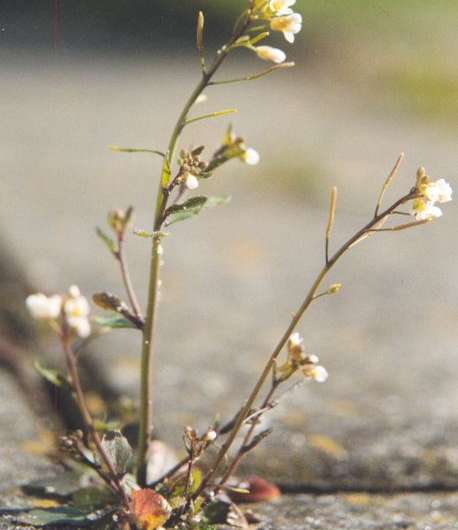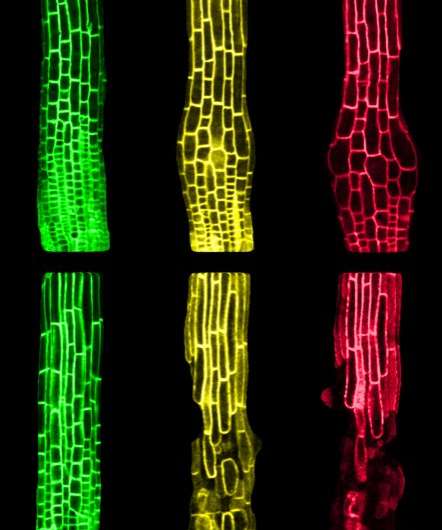New research identifies plant cell wall sensing mechanism

An international collaboration of plant researchers this week reports yet another newly discovered role for the versatile receptor kinase, FERONIA, in the model plant Arabidopsis. The researchers say it acts as a sensor in the plant cell wall to help maintain its integrity and protect the plant from environmental assaults.
How cells sense their physical state and compensate for cell wall damage is poorly understood, say authors led by Alice Cheung at the University of Massachusetts Amherst and collaborator José Dinneny from the Carnegie Institute for Science and Stanford University. But their new analysis of plants exposed to salt stress offers the first experimental evidence and molecular mechanisms showing how FERONIA is essential for the cellular responses that ensure survival under high salinity.
Details are online now and will be in the March 5 issue of Current Biology.
As Cheung explains, "The chemical composition and properties of the cell wall are very complex. Even after decades of intense research, we still don't know all that much about it. Cell wall was considered a 'dead tissue' for a long time, but over time we have learned that it actually is a highly dynamic structure capable of undergoing rapid and extensive modification on demand. It is constantly sensing environmental conditions and communicating with other parts of the cell, which adjust and communicate in a feedback loop to affect conditions at the wall."
"This paper shows for the first time that FERONIA is an essential part of this wall-to-cell communication. Without FERONIA, the cell wall loses its ability to sense," the molecular biologist adds.
For these investigations, molecular geneticist Dinneny and colleagues worked with an Arabidopsis line, previously studied in the Cheung lab, that has lost the FERONIA gene so it cannot tolerate high salt conditions in the environment and will stop growing. A normal plant can adapt to some salt and with time will recover enough to grow, Cheung points out. She adds, "in some parts of the world, high soil salinity is a problem that severely reduces agricultural outputs, so understanding how plants might withstand high salts is important to solve food production issues."
Dinneny and colleagues found that salinity causes the cell wall to soften. "Lacking FERONIA, the mutant plants fail to sense the loss in cell wall integrity to trigger the needed cellular remedy for reinforcement. This leads to root cells exploding in the mutant plants rather than regaining growth as normal plants would do," they write.

Knowing that Cheung's research group had FERONIA-related cell wall data that could provide a mechanistic basis for their observation, the Stanford researchers proposed a collaboration.
Cheung says purifying the FERONIA protein presented the first big challenge. With that accomplished, her laboratory's contribution was to use the purified protein and fragments of cell wall, made up of a sugar polymer called pectin, in several different assays to establish the protein's interactions with the cell wall, a prerequisite for it to act as a "sensor."
The two U.S. groups, with two others in France and Germany, did more experiments to complete the study, Cheung says. The French group carried out atomic force microscopy, an advanced technology that can probe cell wall strength, while the German group carried out analyses related to calcium ion responses that are important to maintain cell wall integrity during salt stress. She adds that these two labs' expertise complemented her own lab's biochemical and molecular expertise and the Dinneny group's developmental and stress physiological expertise.
"This work is another example of how biological research often gets done in this era, through collaboration," she points out.
As Cheung explains, scientists once thought that FERONIA was involved only in female plant reproduction, thus by tradition it was named for a Roman fertility goddess. But she and colleagues changed that notion when they reported in 2010 that FERONIA is required for many and varied plant growth and survival processes. This opened a whole new research community that now involves many groups around the world, she says.
Cheung says, "This most recent study and previous reports from many laboratories have clearly established that FERONIA is more like a command center, the goddess at the center of communication for many ongoing processes. One of the reasons FERONIA can do so many things is that it regulates a cellular pathway that is very broad, with many side branches."
"Another reason could be that FERONIA binds with the cell wall, which is outside the cell membrane and at the front line of interactions with multiple agents from the outside and with molecules secreted from inside cells," she adds, as shown in this new work. Her group is continuing to work on discovering additional ways that FERONIA functions to maintain its "goddess" stature.
More information: Current Biology (2018). DOI: 10.1016/j.cub.2018.01.023
Journal information: Current Biology
Provided by University of Massachusetts Amherst




















